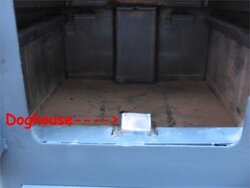So I wanted to throw this out there to the wood burning gods and see what else I can learn. In terms of burning wood, wood stoves & stove behavior I am still pretty green and want to learn. It will only help me become a better more efficient burner.
This scenario has happened twice to me in the last month or so and it has me curious as to what, why & how. I'll do my best to explain things and if I left anything out just holler.
This a typical nighttime load that easily gets me through 8-9 hours with good heat and big cunks of red hot coals in the morning.
Roughly 9:45pm, stove top temp 250-300, rake coals forward, open air all the way, load N/S with what I would call roughly a 3/4 load. Somewhere in the neighborhood of 8-10 splits. They are a tad short as they were cut for a different stove so they don't fill the box all the way to the front and they are not loaded tight up against the secondaries.
By 10:00pm load has started to burn quite well, temps climbing over 400, start to cut back air to say half. No secondaries yet but she's close.
10-15 mins later air has been cut back to less than 25%, stove top is 600-650, secondaries going. Another 5 mins or so of this and I cut the air all the way back. Temp in the 650-700 degrees. I've also regulated the dog house air, sometimes all the way to nothing.
One night I was still up about 10 mins later and the secondaries quit firing. Wood has some nice glowing red areas that are doing the "burning" but no flames. Temps still in the 675 range. 5 mins pass, 10 mins pass..... the secondaries never fire again, temps drop 25-50 degrees. It's like all the gasses are building up but not burning.
The first night I cracked the handle a little and before I had it all the way up she went off like a mini bomb. The second time I cranked the air all the way open and it still took 4-5 mins to get the secondaries to fire.
I've checked the wood, it's all in the 18% range. Some oak, maple or other harder wood for the longer burns. Do I need to let this go a little longer on say 25% of main air and let the secondaries kick in longer before shutting her down to get more of the wood burning/off gassing? Seems like it's starving for air at the secondaries or temps have dropped too much to make them fire. I dunno (shrug).
Understanding what's happening will only help me in fixing the problem, if there is a problem. Next time it happens I may just let it do it's thing and stay up and watch. Thanks guys.
This scenario has happened twice to me in the last month or so and it has me curious as to what, why & how. I'll do my best to explain things and if I left anything out just holler.
This a typical nighttime load that easily gets me through 8-9 hours with good heat and big cunks of red hot coals in the morning.
Roughly 9:45pm, stove top temp 250-300, rake coals forward, open air all the way, load N/S with what I would call roughly a 3/4 load. Somewhere in the neighborhood of 8-10 splits. They are a tad short as they were cut for a different stove so they don't fill the box all the way to the front and they are not loaded tight up against the secondaries.
By 10:00pm load has started to burn quite well, temps climbing over 400, start to cut back air to say half. No secondaries yet but she's close.
10-15 mins later air has been cut back to less than 25%, stove top is 600-650, secondaries going. Another 5 mins or so of this and I cut the air all the way back. Temp in the 650-700 degrees. I've also regulated the dog house air, sometimes all the way to nothing.
One night I was still up about 10 mins later and the secondaries quit firing. Wood has some nice glowing red areas that are doing the "burning" but no flames. Temps still in the 675 range. 5 mins pass, 10 mins pass..... the secondaries never fire again, temps drop 25-50 degrees. It's like all the gasses are building up but not burning.
The first night I cracked the handle a little and before I had it all the way up she went off like a mini bomb. The second time I cranked the air all the way open and it still took 4-5 mins to get the secondaries to fire.

I've checked the wood, it's all in the 18% range. Some oak, maple or other harder wood for the longer burns. Do I need to let this go a little longer on say 25% of main air and let the secondaries kick in longer before shutting her down to get more of the wood burning/off gassing? Seems like it's starving for air at the secondaries or temps have dropped too much to make them fire. I dunno (shrug).
Understanding what's happening will only help me in fixing the problem, if there is a problem. Next time it happens I may just let it do it's thing and stay up and watch. Thanks guys.



